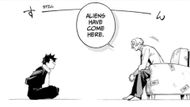Jujutsu Kaisen Modulo takes an unexpected sharp turn into interstellar territory, abandoning Earth-bound curses for something far more ambitious. Gege Akutami's decision to catapult his supernatural saga sixty-eight years into the future wasn't just about aging up characters—it was about rewriting the entire rulebook.
Space invaders have officially entered the jujutsu battlefield through Jujutsu Kaisen Modulo, specifically in the form of Maru, a Simurian refugee whose powers mirror cursed energy manipulation. Rather than treating extraterrestrial elements as novelty additions, Akutami weaves them directly into the fabric of his established mythology. The alien integration serves as both a plot catalyst and a philosophical challenge to everything readers thought.

The opening chapter of Jujutsu Kaisen Modulo wastes no time in setting up its extraterrestrial premise. Maru arrives on Earth with mysterious powers that mirror jujutsu techniques. His presence creates intrigue among the new protagonists and readers alike. The alien's unfamiliarity with human society serves as an effective narrative device.
This sci-fi element allows Akutami to explore fresh storytelling possibilities. The introduction of otherworldly beings opens doors to cosmic-scale conflicts. This new installment allows the story to extend beyond Earth while still preserving its supernatural roots.
The sequel focuses on Yuka and Tsurugi Okkotsu, descendants of fan-favorite characters Yuta Okkotsu and Maki Zenin. The siblings inherit both the legacy and burden of their legendary grandparents. Yuka takes center stage as the main protagonist, while her brother Tsurugi is notable for having no cursed energy at all. Their dynamic creates compelling character tension from the outset. The duo's relationship with Maru forms the story's emotional core.
How Aliens Fit the Jujutsu Kaisen Modulo

Despite initial skepticism about extraterrestrials in the jujutsu universe, the concept integrates surprisingly well. Maru's powers complement the established magic system rather than contradicting it. Overall, Jujutsu Kaisen Modulo stays true to the original series while greatly broadening its scope.
The alien existence handles lingering questions from the original series' conclusion. Instead of dwelling on unresolved plot threads, the sequel diverts toward new mysteries. This strategy prevents the story from becoming bogged down in unnecessary exposition about past events.
The sequel showcases significant technological advancement within jujutsu society. Barrier techniques have evolved to include teleportation capabilities that were once exclusive to elite sorcerers. Jujutsu Kaisen Modulo demonstrates how cursed energy applications have progressed over seven decades.

Non-sorcerers can now utilize cursed tools through talisman activation systems. This development democratizes supernatural abilities to some extent. The technological integration reflects natural progression within the magical world's infrastructure.
A Bold New Direction
Jujutsu Kaisen Modulo depicts a visionary risk that seems to be paying dividends early. The alien integration feels natural rather than forced or gimmicky. Akutami's decision to adopt science fiction elements while honoring the original's foundation demonstrates mature storytelling instincts.
The sequel successfully sets its own identity while respecting its predecessor's legacy. Whether this extraterrestrial gambit will nurture reader interest remains to be seen, but the initial footing appears solid.
